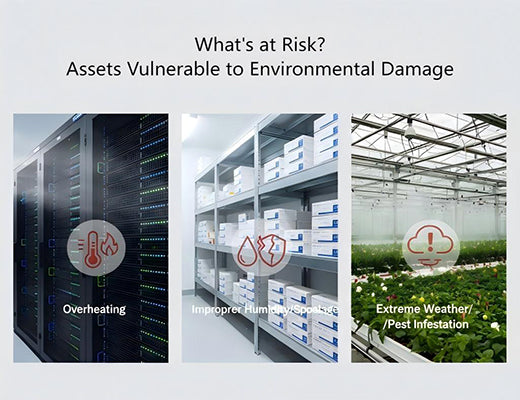
How to Set Up an IoT Environmental Monitoring System with the S6000U
|
|
Time to read 5 min
|
|
Time to read 5 min
This guide provides a practical, step-by-step approach to setting up an IoT environmental monitoring system using an all-in-one sensor like the Robustel S6000U. We'll show you how this solution allows you to proactively monitor critical parameters like temperature and humidity in real-time, connect your sensor to the cloud via a reliable industrial gateway, and configure instant alerts to protect your valuable assets from environmental damage.
IoT environmental monitoring is a proactive strategy to prevent catastrophic damage to sensitive assets in locations like server rooms, warehouses, and greenhouses.
The core benefits are preventing asset loss, ensuring regulatory compliance with automated data logging, and reducing operational costs.
An all-in-one sensor hub like the S6000U drastically simplifies installation by combining multiple sensors (temperature, humidity, etc.) into a single device.
The system requires a sensor, a cellular gateway for reliable connectivity (to send alerts during a power outage), and a cloud platform for data logging and real-time alerts.
I'll never forget the call from a panicked IT manager. He had returned to the office on a Monday morning to find the entire company offline. The cause? The server room's air conditioning unit had failed over the weekend. His simple temperature alert either failed or was missed. By the time he arrived, the servers had all shut down from overheating, causing a catastrophic data loss and a full day of business downtime.
His mistake? He thought monitoring the server room meant just watching the thermostat.
Let's be clear: a modern server room is a delicate ecosystem. Temperature is just one of many threats. A truly resilient strategy requires comprehensive IoT environmental monitoring.

Before diving into the setup, it's crucial to understand the high-stakes problems this technology solves. A robust IoT environmental monitoring system is your first line of defense.
Instead of juggling multiple different sensors, an all-in-one sensor hub like the Robustel S6000U simplifies this step dramatically. It combines temperature, humidity, light, noise, and more into a single, easy-to-install device.
Your sensor needs a way to send its data to the internet. This is the job of an industrial gateway or router.
Data is useless without action. The final step is to set up your alerting rules in a cloud platform like RCMS.

Setting up an IoT environmental monitoring system is no longer a complex, multi-vendor integration project. By combining a powerful, all-in-one sensor hub like the S6000U with a reliable industrial cellular gateway, you can deploy a professional-grade monitoring and alerting system in a fraction of the time. It's an accessible, high-ROI investment that acts as your 24/7 watchdog, protecting your most valuable assets from preventable disasters.
Learn more in our main guide:

A1: Because the S6000U uses the standard Modbus RTU protocol over RS485, you can connect multiple S6000U devices (each with a unique slave ID) to a single RS485 bus, which then connects to one port on your gateway. This allows you to monitor multiple zones with a single gateway.
A2: This is a critical feature. Your connectivity gateway (the industrial router) should be connected to a small Uninterruptible Power Supply (UPS). Because the router uses its own cellular connection (independent of your building's internet), it will remain online during a power outage and can be configured to send an immediate alert notifying you that the main power has been lost.
A3: A simple sensor typically measures just one thing. A sensor hub like the S6000U is far more powerful. It has multiple sensors built-in (temperature, humidity, vibration, etc.) and it has interfaces like RS485 that allow it to connect to and read data from other third-party sensors or devices, acting as a local data concentrator before passing everything to the gateway.